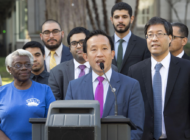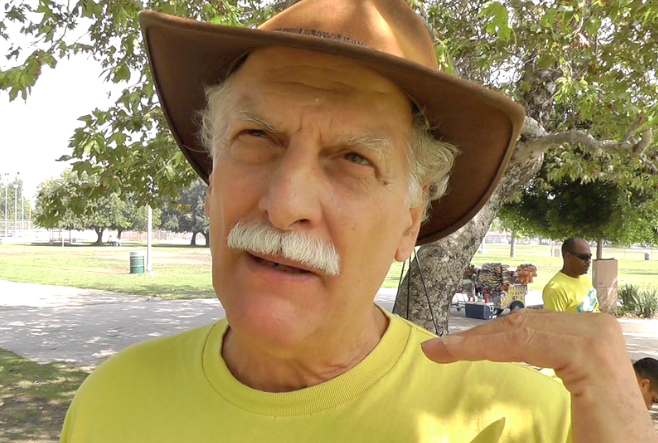The city of Sacramento, California, still struggles with how to meet the needs of its homeless population. Churches and local volunteers have stepped in to help with Mayor Kevin Johnson leading the way. But officials say about 1,200 people are still without a roof over their heads everyday.
by Karoline Steavenson
EL NUEVO SOL
Giovanni Hodges lives in a tent by the American River in Sacramento. He’s got the guileless demeanor of a middle school kid and the slightly freckled face to match, yet he is 31. After being released from prison where he spent eight months on a weapons charge he took for a buddy, he’s back in community college and homeless.
“The Oprah Show” brought homelessness in Sacramento international attention a year ago when its tent city of recession casualties was exposed. As a result, Mayor Kevin Johnson placed the issue at the heart of his administration. Nonetheless, many people are still living outdoors in tents alongside the river.
The same city that made such a public fuss about helping these unhappy campers also authorized its police officers to issue tickets to them for illegal camping.
Dale Jones, unemployed maintenance technician, 18 year Sacramento resident and activist for the homeless, got two camping tickets last week.
“I’ve been going to city council with Safe Ground and we’re trying to get the law repealed,” Jones said. “I suddenly become homeless and …so now that I’m homeless I’m a criminal? That’s not right.”
Cassandra Jennings, Assistant City Manager, says city officials are working with Safe Ground to find a suitable solution for all.
“It’s illegal to camp outside so the people camping should not be out there. It’s not safe. There are health and other issues involved with that and I think people deserve better. We have been working and looking at alternatives our goal is to get everyone in permanent housing,” Williams said.
“We had a workshop with them a couple of weeks ago and I think it was clear to me that they certainly want to help, but any construction they want has to meet minimum safety and building code standards,” Williams explained.
Anne Moore, Homeless Liaison for Mayor Johnson’s office, said the city is not pursuing the idea of providing a lot in the city for the homeless.
“Safe Ground is working with architects and designers pro bono to possibly buy a lot,” Moore said, but the city doesn’t plan to run such a site.
Moore and Williams both said Sacramento has various forms of infrastructure and housing available to those who find themselves without a roof over their heads.
Moore also said, “The focus on the homeless programs and federal funding is to prevent people from becoming homeless.”
That goal doesn’t seem to be in force for Laura Buckner, 55, and a Sacramento resident for 25 years.
Buckner was evicted from her apartment on Nov. 29. She is a full-time college student at Sacramento City College and had been waiting for her student loans to arrive in time to pay her past-due rent. They did not get funded in time.
“I called places …and there was nobody to help me. So on the first I went to Mary House and they’re really helpful,” Buckner said.
Mary House is a day shelter for women and is part of Loaves & Fishes, a private charity run by Sister Libby Fernandez. Loaves & Fishes is a central hub of services for the homeless in the city and an advocate for Safe Ground. They do not have housing but offer other aid. They serve lunch daily, have a basic medical clinic, clothing, addiction help, referrals to city services and other support services.
Buckner’s 30-year-old disabled son also lost his housing when she got evicted since he was living with her.
Buckner and her son have been staying in various church overflow shelters for the past week. Several churches in Sacramento have opened their doors to the homeless. Churches that have agreed to participate do so once or twice a month or more and also serve their guests dinner and breakfast. These efforts are all handled by volunteers.
Mayor Johnson’s office released information in November stating that the new agency he formed, the Sacramento Steps Forward Policy Board to End Homelessness, had managed to reduce chronic homelessness by one third from 2007 to 2009. But information published in that same agency’s 2010 Homeless Employment Report shows a different side of the story.
From 2009 to 2010 homelessness due to job loss increased by three percent, homelessness due to eviction increased two percent, and homelessness due to domestic violence increased by 14 percent.
Overall, homelessness due to economic reasons increased from 70 percent to 71 percent this year.
The report also says that 90 percent of Sacramento’s homeless want to work full-time.
| Cause of Homelessness | 2009 | 2010 |
| Insufficient Income | 38.9% | 36.8 |
| Lost Job | 31.1% | 34.0 |
| Other: [include kicked out by parent, incarceration, divorce, house burned down, death of a loved one] |
29.4% |
24.7 |
| Disability | 26.1% | 16.5 |
| Substance Abuse | 20.0% | 15.4 |
| Eviction | 14.4% | 16.5 |
| Health Issues | 12.8% | 8.0 |
| Foreclosure | 6.1% | 3.0 |
| Domestic Violence | 0.5% | 14.3 |
| Overall Economic Reasons | 70.0% | 71.0% |
While the city holds meetings and charities search for donors to help them buy land for camping, Giovanni Hodges studies in his tent by the light of two $5 LED battery powered lanterns.
“I’ve got a whole bunch of blankets and stuff. I buy these little cans of heat and they open up and as long as you keep them…on something wooden you’re fine, it really helps,” Hodges said.
He’s in six units of classes and is getting good grades plus works on completing his high school GED at an adult school. He also took high school classes while he was in prison in Coalinga.
“I talked to college counselors about (housing) before but there’s nothing they can do for me because there’s no onsite housing,” said Hodges. “The best they could do for me is say go to a career college or go to a technical school. There are a lot of them in the Sacramento area and they will pay for a motel for you… or they have dorms, but that’s not what I want to go to school for.”
Hodges wants to major in business.
“This next semester I’m going to take some health classes and I’m going to take some book writing classes, non-fiction writing,” Hodges said. “Right now I’m working on two different books.”
For more information –
Map of Some Homeless Services in Sacramento and Related Sites
View Homeless Services in Sacramento in a larger map
Homeless Employment Report 2010
Volunteers of America Housing Assistance
Goodwill of Sacramento Street Sheet of Services for the Poor
Mayor’s Press Release on Anniversary of Sacramento Steps Forward
Press Release That Over 1,000 Families Have Found Housing
Interview With Sister Libby, Director of Loaves & Fishes
Other ENS stories related to this topic:
The Great Recession: A Tougher Storm to Battle in the Street by DIANA GARDUÑO
Tags: charity churches faith-based services homelessness low income recession Sacramento unemployment




















